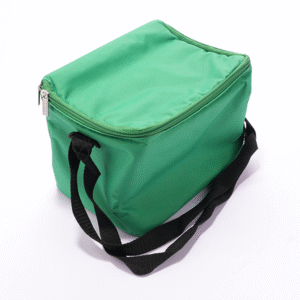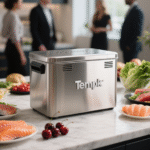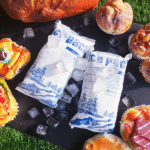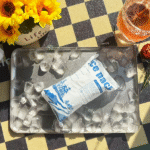Cold chain air freight: ensuring perfect temperature control
Mis à jour 13 Novembre 2025
Dans 2025, cold chain air freight is more essential than ever. You’re moving life saving vaccines, biologics and perishables across continents under tight temperature controls. Even a small excursion can spoil millions of dollars’ worth of product and jeopardise patient safety. This comprehensive guide answers your most pressing questions about temperature controlled air cargo, highlights the latest standards and technologies and shows you how to ship successfully. Cold chain air freight appears in the first 50 words to signal the focus of this article. Global cold chain logistics are worth over US$324 billion and are projected to reach US$862 billion by 2032, making 2025 a pivotal year for innovation and compliance.

Why maintaining strict temperature ranges (+2 °C à +8 °C, deep frozen or ambient) matters for pharmaceuticals and perishables.
Which industry standards (PIB, IATA CEIV Pharma/Fresh, FSMA, OMS) and regulations govern temperature controlled air cargo.
How active and passive containers, Capteurs IoT, predictive analytics and AI improve reliability.
Practical best practices for packaging, lane risk assessment and pre alerts.
Challenges in cold chain air freight, including inconsistent infrastructure, customs delays and cost.
New trends for 2025: digital visibility platforms, hybrid packaging and sustainability.
What challenges do cold chain air freight operators face in 2025?
Cold chain air freight involves more than placing goods in an insulated container; it requires orchestration across airports, carriers and ground handlers. Industry experts warn that packaging alone cannot guarantee product integrity because handling errors, transit delays and inconsistent storage conditions expose cargo to extreme temperatures. Air cargo volumes are projected to grow by 5.8 % dans 2025 à 72.5 million tonnes, yet available cargo capacity will only increase by around 4.4 %, creating bottlenecks. This imbalance, coupled with geopolitical unrest and unexpected disruptions, means that the cold chain must be resilient.
Risks across the journey
Every stage of the journey introduces risks:
| Scène | Key risks | Signification pratique |
| Origin pick up & pre conditioning | Insufficient pre cooling can start shipments at incorrect temperatures; outdated infrastructure and synthetic refrigerants create inefficiencies. | Start shipments at the right temperature by conditioning goods and containers; invest in modern cold rooms and eco friendly refrigerants. |
| Airport hand over | Handling errors and prolonged tarmac exposure can cause temperature excursions. | Use rapid transfer corridors and dedicated cold chain zones to minimise tarmac time and maintain temperature. |
| Vol & transit | Limited cargo capacity and delays increase time in transit; dry ice restrictions (2.5 kg per passenger package and up to 200 kg sur les vols cargo) require careful planning. | Select optimal routes and carriers; ensure containers carry enough refrigerant and comply with dry ice limits and venting requirements. |
| Customs & border clearance | Complex customs procedures and documentation demands cause hold ups, exposing cargo to uncontrolled environments. | Prepare documentation in advance and utilise priority clearance programs; choose corridors with harmonised standards. |
| Livraison du dernier kilomètre | Final transfer to hospitals or retailers may lack cold rooms or trained staff; door openings create temperature spikes. | Train last mile providers, use GPS tracked vehicles with multiple temperature zones and emphasise strict procedures. |
Compliance burdens and security threats
Operators must navigate a labyrinth of regulations. Pharmaceutical shipments must comply with Good Distribution Practices (PIB), Analyse des risques et points de contrôle critiques (HACCP) pour la nourriture, les États-Unis. Loi sur la modernisation de la sécurité alimentaire (FSMA) and EU GDP / GMP Annex 11 exigences. IATA’s Temperature Control Regulations mandate the use of a Temps & Temperature Sensitive label and a Standard Acceptance Checklist for every shipment, Pendant que le CEIV Pharma/Fresh certification program ensures training, validated equipment and risk management. Airlines and shippers must also follow dry ice regulations—passenger flights permit only 2.5 kg de glace sèche par colis, whereas cargo flights may allow up to 200 kg—to mitigate CO₂ build up risks.
Security threats are rising too. Cargo theft incidents surged 27 % in the past year, and cyberattacks targeting digital logistics systems can disrupt operations. High value pharmaceuticals are attractive targets; donc, operators must integrate security screening, tamper evident packaging and cybersecurity measures.
Capacity and infrastructure constraints
Infrastructure at many airports is aging, with cold storage facilities built decades ago requiring upgrades and modernisation. Ageing refrigeration units use harmful refrigerants such as HCFCs and HFCs; regulatory pressure is forcing a shift toward sustainable refrigerants and energy efficient systems. Limited space at airports means cargo is sometimes stored in off airport facilities, which introduces new hand offs and potential breaks in the cold chain. The continuing e commerce boom adds volume—online sales will account for around 20.8 % of total retail in 2024 and are forecast to grow 14 % annually through 2026—pushing capacity even further.
Which technologies improve temperature controlled air cargo efficiency?
Advanced technology makes cold chain air freight possible by providing real time visibility and predictive insights. Dans 2025, investments in software that improves visibility across the supply chain are increasing. Below are the key innovations reshaping air freight cold chains.
Active and passive containers
Modern containers come in two broad categories:
| Type de conteneur | Description | Impact on your operations |
| Active containers | Equipped with battery powered cooling or heating systems; maintain internal temperature independently for long-haul flights. Often used for pharmaceuticals and biologics requiring narrow ranges (+2 °C à +8 °C or deep frozen). | Provide precise control and reduce risk of excursions during delays; cependant, they are heavier and more expensive. |
| Passive containers | Use insulated materials and phase change materials (PCMS) like gel packs or dry ice to maintain temperature. Suitable for shorter routes or when weight restrictions apply. | Lower cost and energy consumption but require careful payload preparation and accurate loading of refrigerants. |
More sophisticated designs combine vacuum insulated panels (Vips) with PCMs to extend hold time. VIPs are valued at roughly US$2.5 billion in 2025 and are projected to reach US$5 billion by 2033. PCMs provide precise temperature control and are reusable, offering longer cooling duration than gel packs.
IoT sensors and real time monitoring
Continuous monitoring is the backbone of a safe cold chain. IoT enabled sensors track internal temperature, humidité, shock and GPS location, sending alerts when excursions occur. Advanced systems display real time dashboards, provide environmental alarms and record audit trails to support regulatory compliance. Par 2025, the global market for cold chain tracking and monitoring is projected to reach €1.8 billion (source search result) as companies invest in visibility.
Predictive analytics uses historical data to forecast equipment failures and route specific risks. AI algorithms optimise flight schedules and resource allocation. The global AI market in logistics is expected to reach US$348.62 billion by 2032, highlighting its transformative potential.
Blockchain and transparent records
Blockchain technology creates tamper proof records of shipments, including temperature data at each checkpoint. Airlines using blockchain have reported a 7 % reduction in cargo handling costs and a 90 % decrease in communication errors. The immutable ledger ensures all stakeholders—from shippers to customs authorities—access the same trusted information, speeding up customs clearance and reducing paperwork. Sur 70 % of logistics firms plan to integrate AI with blockchain systems, demonstrating momentum toward unified digital platforms.
Smart cold chain management and autonomous logistics
Smart cold chain management integrates IoT sensors, real time monitoring and specialised insulated containers to ensure products maintain their required ranges. Rapid ramp transfers and minimised storage times reduce exposure to ambient conditions. Entre-temps, AI driven route optimisation and autonomous vehicles (including drone deliveries) reduce transit times and carbon emissions. These innovations not only protect goods but also cut costs and improve sustainability.
Sustainable refrigerants and eco friendly packaging
Environmental sustainability is a growing priority. Hydrofluoroolefins (HFOs) and CO₂ based refrigeration systems offer effective cooling with low global warming potential. Reusable insulation materials and recycled packaging minimise waste. Solar powered refrigeration units enable cold storage in regions with unreliable electricity supply. Many airlines also aim to replace at least 10 % of their fuel with Sustainable Aviation Fuel (SAF) par 2030; the EU aims for 2 % SAF use by 2025. While not directly controlling temperature, these measures reduce the environmental footprint of cold chain air freight.
How to comply with regulations and standards for cold chain air freight?
Regulatory compliance protects product integrity and avoids costly penalties. Dans 2025, global and regional frameworks set stringent requirements for temperature controlled air cargo.
Global regulations
Bonnes pratiques de distribution (PIB): WHO and EMA guidelines emphasise temperature control, validated systems and traceability.
Analyse des risques et points de contrôle critiques (HACCP): Identifies potential hazards in food transport and defines critical control points.
Loi sur la modernisation de la sécurité alimentaire (FSMA): Requires preventive controls and documentation for food manufacturers in the U.S..
EU GDP and EU GMP Annex 11: Cover handling, storage and electronic systems for medicinal products.
FDA & USDA guidelines: NOUS. agencies define transport conditions for drugs and certain perishable foods.
WHO vaccine guidelines: Emphasise the 2–8 °C range for vaccines and proper documentation.
Air cargo–specific rules complement these frameworks:
Réglementation IATA sur le contrôle de la température (TCR): Mandate a Temps & Temperature Sensitive label and require shippers to complete a Standard Acceptance Checklist.
CEIV Pharma and CEIV Fresh certification: IATA’s program verifies that carriers and ground handlers have trained staff, validated equipment and risk management protocols. Many carriers highlight their CEIV status to build customer trust.
Dry ice limits: Passenger flights may carry a maximum of 2.5 kg de glace sèche par colis, while cargo flights can allow up to 200 kg. Packaging must be vented and labelled with “Dry Ice,"Et 1845 et le poids net.
Building a compliant cold chain
Accurate temperature maintenance: Define each product’s range and use appropriate equipment—from ultra low freezers for gene therapies to refrigerated trucks with multiple zones. Regularly maintain and calibrate equipment to ensure consistent performance.
24/7 surveillance & alerting: Deploy calibrated sensors and automated data loggers to track temperatures continuously; set notifications via SMS/email for immediate action.
Validated infrastructure & conditionnement: Use certified warehouses and containers; choose thermal shippers with gel packs, dry ice or PCMs; validate packaging to sustain required ranges for the entire journey.
Secure storage environments: Control access to cold rooms; monitor humidity and door openings; use alarmed doors to prevent temperature fluctuations.
Documentation & traçabilité: Maintain digital records of temperature logs, calibration certificates, training and deviations; blockchain can automate this process and provide audit trails.
Sops & entraînement: Develop standard operating procedures and provide regular training to all personnel involved in packing, handling and monitoring. CEIV training programs ensure consistency across the supply chain.
Contingency planning: Prepare back up power supplies, spare packaging materials and processes for transferring goods to alternate facilities during equipment failures.
What are the best practices for packaging and monitoring in air freight cold chain?
Proper packaging and monitoring are the foundation of safe cold chain air freight. Even the most sophisticated container will fail if mismatched to the product or route. Below are practical recommendations drawn from industry research and real world examples.
Match the product’s thermal profile
Médicaments, biologics and food products have distinct thermal classes. Match shipments to the correct packaging:
For vaccines and insulin (+2 °C à +8 °C), use standard refrigeration and PCMs.
For frozen foods and certain vaccines (–20 ° C), choose containers with dry ice or -20 PCM °C.
For ultra low biologics (–70 °C or lower), deploy cryogenic shippers and real time monitoring.
When planning multi leg flights, consider ambient conditions at each stop; shipping across hemispheres introduces wide temperature ranges and customs delays. Validate packaging through thermal modelling, including worst case scenarios, to ensure it maintains the required temperature even if a flight is delayed by 48 heures.
Conduct lane risk assessments and pre alerts
Evaluate each route’s potential risks—such as extreme climates, congested airports and lengthy customs processes—and select carriers with proven cold chain performance. Set up pre alert systems to notify ground handlers of incoming temperature sensitive shipments so they can allocate resources and expedite unloading.
Build redundancy
Carry sufficient refrigerant or backup PCMs for unexpected delays. When using passive containers, add extra gel packs or PCMs; for active containers, ensure battery backup or charging options. Redundancy also applies to equipment and personnel—have spare sensors, alternate carriers and trained staff ready to step in.
Embrace digital visibility
Leverage IoT monitoring platforms that integrate temperature sensors, humidity sensors and GPS tracking. Real time dashboards allow you to spot temperature excursions and respond immediately. Dans 2025, many companies are implementing visibility software across the entire supply chain, and some examples show that real time alerts prevented thousands of dollars of spoiled goods. Mobile apps enable customers to track shipments and verify conditions upon receipt.
Train and empower your team
Human factors remain critical. Train staff in packaging, sensor placement, SOPs and emergency procedures. Encourage a culture of accountability—any deviation should trigger immediate action. Document lessons learned from incidents and adjust procedures accordingly.
Use interactive tools and assessments
To engage your team and customers, provide interactive tools such as a container selection quiz (helps determine whether to choose active vs passive containers) et un lane risk assessment calculator. These tools can reduce decision making time and improve packaging accuracy, lowering the risk of temperature excursions. Consider including them on your website alongside this article.
Practical case study: A pharmaceutical distributor equipped every pallet with digital temperature sensors and set automated alerts. When a trailer door stayed open too long, the system notified the driver and warehouse. They closed the door quickly, preventing a temperature breach and saving thousands of dollars in perishable goods. This example illustrates how real time monitoring and training can avert losses.
How are sustainability and digital innovation reshaping air freight cold chain?
Cold chain air freight is undergoing a sustainable and digital transformation. La durabilité n’est plus une option; it influences customer choices and regulatory compliance. Digital innovation improves resilience and reduces waste.
Sustainable operations
The air cargo industry is adopting Sustainable Aviation Fuel (SAF); major airlines plan to replace at least 10 % of fuel with SAF by 2030, and the EU’s ReFuelEU initiative targets 2 % SAF usage by 2025. Some carriers offer reusable thermal packaging as part of a rental model; these containers reduce waste and carbon emissions but must balance practicality with reliability. Operators also invest in solar powered refrigeration units and eco friendly insulation materials.
Digital transformation and AI
Advanced analytics and AI optimize route planning, predict delays and manage capacity. AI driven cargo screening and predictive maintenance improve security and reduce human error. Dans 2025, AI algorithms are analysing traffic, weather and demand to recommend optimal schedules and anticipate high risk routes. Blockchain builds transparent, tamper proof records. Real time data platforms integrate monitoring, billing and resource allocation, enabling operators to make decisions quickly.
Expanding markets and connectivity
Emerging markets in Southeast Asia, Africa and Latin America are experiencing double digit trade growth. New hubs and multimodal solutions (integrating air, rail and road) reduce transit times and enhance efficiency. Air cargo will increasingly connect remote producers—such as farmers and biotech start ups—to global markets, while integrating e commerce flows and replenishing urban grocery networks.
2025 new trend:cold chain air freight
Aperçu de la tendance
Dans 2025, cold chain air freight continues to expand, driven by pharmaceutical and food demand. The global cold chain logistics market will grow from US$324.85 billion in 2024 to US$862.33 billion by 2032, un taux de croissance annuel composé (TCAC) de 13 %. Pharmaceutical cold chain revenue is set to exceed US$65 billion in 2025 and double to over US$130 billion by 2034. The market for cold chain pharmaceuticals grew from US$8.85 billion in 2024 to US$10.04 billion in 2025 and is expected to reach US$18.2 billion by 2030. These numbers highlight the increasing importance of resilient and efficient cold chains.
Derniers développements en un coup d'œil
Pharma corridors expansion: New routes with harmonised standards streamline cross border movements; dedicated cold chain facilities at airports enhance reliability.
Digital visibility platforms: Integration of IoT sensors, AI analytics and blockchain provides real time tracking, predictive insights and tamper proof records.
Hybrid packaging solutions: Combining active cooling with passive insulation, and reusable containers under rental models, reduces waste and enhances temperature stability.
Sustainable innovations: Adoption of SAF and eco friendly refrigerants lowers carbon emissions; reusable packaging models offer circular solutions.
AI driven predictive maintenance & autonomous logistics: AI algorithms forecast equipment failures and optimize routes, while autonomous delivery vehicles begin to handle last mile segments.
Insistance au marché
E commerce remains a critical growth engine. Online shopping represented around 20.8 % of retail in 2024 and is projected to grow 14 % chaque année à travers 2026. Cependant, analysts caution that overreliance on e commerce could leave a gap if growth slows. Capacity constraints persist—while air cargo volumes may rise 5.8 % dans 2025, available capacity is expected to increase only 3–4 %. Airlines are therefore investing in dedicated freighters and partnerships with third party logistics providers to balance demand.
Trade growth in emerging markets is creating new air freight corridors, particularly in Southeast Asia, Africa and Latin America. These routes require robust cold chain infrastructure, including temperature zoned storage rooms and rapid transfer corridors. Upgraded cold storage facilities and larger distribution centres near production areas are being developed to improve proximity to customers.
FAQ
Question 1: What temperature ranges are required for pharmaceuticals during air freight?
Pharmaceuticals typically require +2 °C à +8 °C, but some products need deep frozen conditions (–20 ° C) or ultra low temperatures (–70 °C or lower). Determine the product’s thermal class and choose containers accordingly.
Question 2: What is the difference between active and passive air cargo containers?
Active containers have built in cooling systems powered by batteries or external power; they offer precise control and are ideal for long haul flights. Passive containers rely on insulation and PCMs or dry ice; they are lighter and less costly but have limited duration.
Question 3: How can I monitor my shipment during flight?
Use IoT data loggers that record temperature, humidity and location and transmit data in real time. Many platforms send alerts via SMS or email when conditions deviate from preset thresholds.
Question 4: Why is CEIV Pharma/Fresh certification important?
CEIV Pharma/Fresh certifies that airlines, handlers and forwarders meet IATA’s rigorous standards for temperature control, staff training and risk management. It assures shippers and regulators that shipments are handled consistently and safely.
Question 5: What are the maximum dry ice limits for air freight?
Dans 2025, passenger flights allow a maximum of 2.5 kg (5.5 kg) de glace carbonique par paquet, while cargo flights may permit up to 200 kg (440 kg). Packages must be vented and labelled with “Dry Ice," l'ONU 1845 code and the net weight.
Suggestion
Cold chain air freight in 2025 demands meticulous planning, compliant procedures and cutting edge technology. Remember these key points:
Plan holistically: Packaging is only one piece; assess every touchpoint, from pre conditioning to last mile delivery.
Tirer parti de la technologie: Use active or passive containers, Capteurs IoT, predictive analytics and blockchain for real time visibility and predictive maintenance.
Suivre la réglementation: Adhere to GDP, HACCP, FSMA, IATA TCR and CEIV programmes; comply with dry ice limits and calibration standards.
Investir dans la durabilité: Adopt eco friendly refrigerants, reusable packaging and SAF usage.
Train and collaborate: Continuous training, strong coordination and clear communication across partners ensure the cold chain remains unbroken.
Étapes suivantes: evaluate your current air freight processes against the practices outlined here. Conduct a lane risk assessment, validate your packaging solutions and explore IoT monitoring platforms. Consider partnering with CEIV certified carriers and investing in sustainable technology. Pour un accompagnement personnalisé, speak with our cold chain experts.
À propos Rotation
Tempk is a leader in cold chain packaging and monitoring solutions. Nous specialise in insulated containers, Matériaux à changement de phase, gel packs and IoT data loggers that protect temperature sensitive goods. Notre R&D centre continuously develops eco friendly materials and validated shippers. Tempk’s products are rigorously tested to meet GDP, IATA and FDA standards. We also provide consultation to design compliant cold chain systems, helping our clients reduce spoilage and improve sustainability.
If you’d like to optimise your cold chain air freight or explore our product range, contact us for a custom consultation. Our team can guide you through container selection, monitoring solutions and regulatory compliance.























